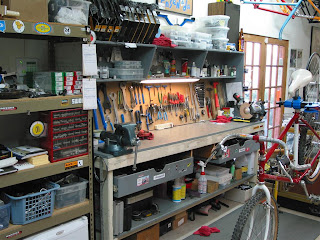By blackmountaincycles,
Filed under: Working on bikes
However, what you would expect and what you would get are, sometimes, two different things. In this guys case, three different mechanics who were supporting the ride told him three different things. One told him he needed another spacer behind his cogset (10 speed Dura Ace) and installed one. Another told him he had too many spacers and removed one. The third told him he needed to drip some lube at the spot where the cassette body meets the hubshell. This guy was closest, but dripping lube around the tiny gap isn’t going to get the lube where it’s needed – inside the cassette body and around the Igus bushing.
As the rider is explaining all this to me, he keeps telling me that one of the mechanics is licensed. Now, I’m not quite sure what that means because I’m licensed too. Licensed to operate a 4-wheeled vehicle on the roads of our country and some other countries as well. But he explained that this guy was a licensed mechanic with “S-Ram.” Went to school and everything. Wow, that’s impressive. What the “mechanic” doesn’t know or can’t figure out is that there should be just enough spacers behind the freehub body so that the 1st position cog sits just to the outside of the edge of the cassette body so when the lockring is tightened, it tightens against the cog and not the cassette body. If it takes one spacer, it takes one spacer. If it needs two spacers, then it needs two spacers. Nor did he know that Mavic wheelsets need to have the freehub body removed, cleaned and lubed periodically.
So, I tell him I can fix his bike and, in 15 minutes, I’ll have him back on the road so he can continue his century ride. Pull the cassette body, clean it, drip some Phil oil on the pawls, around the bushing – just a nice coating of oil. Put it back together (loosening the preload on his left bearing because it is way too tight and it’s difficult to turn the axle by hand), use two 1mm spacers behind his cassette, tighten lock-ring, install wheel, make sure limit screws are correctly adjusted (they weren’t), run it through the gears, freewheels just fine, check over rest of bike (front brake pads were worn way past the wear lines so a new set of D/A pad inserts goes on), and like I told him 15 minutes later, he’s back on the road to finish his century.
He was pretty amazed that I could fix his bike – some middle-aged guy in a back country bike shop did what the licensed mechanic couldn’t. He still wasn’t quite sure it would work so I told him to ride around the block, coast down the hill and if it worked, keep going. If it didn’t come on back. I never saw him again.
I’m not sure what they teach in bike schools or what it takes to get a license, but it doesn’t seem to be working (at least in this case). Don’t get me wrong, I think folks can take away a lot of good information from mechanic’s schools, especially in the arena of suspension fork rebuilding and hydraulic brake maintenance and repair. However, I think some of the pupils come away with a pretty rigid mind-set with regards to bike repair. Sometimes you have to think for your self and think outside the box. That’s not a class you can take. Trust me, I’m a bike mechanic and I learned from the best, Chuck Hoefer at Pacific Coast Cycles.
(What’s playing: John Prine and Iris Demet (We’re Not) The Jet Set)

Leave a Reply